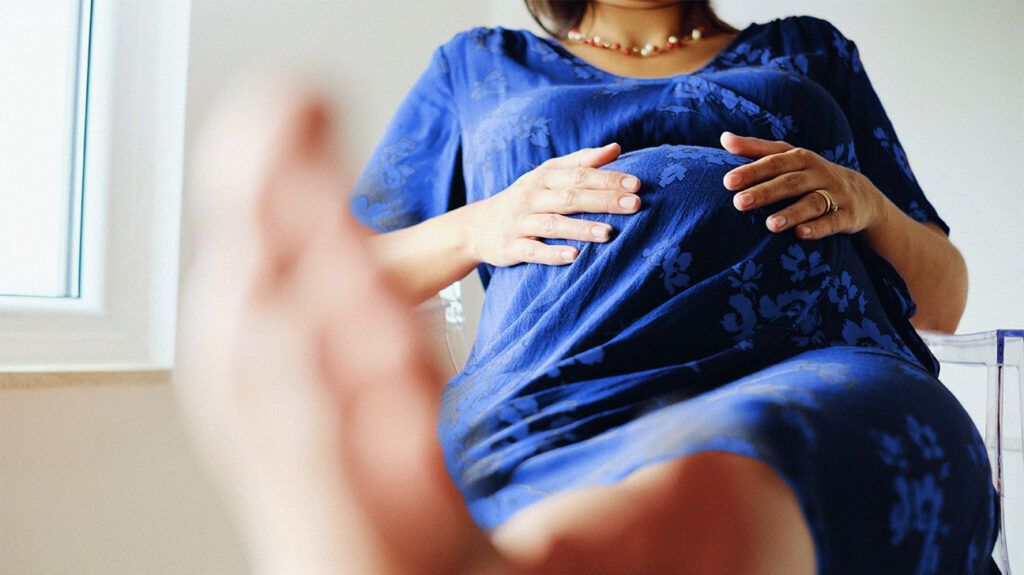Preeclampsia-related swelling tends to be sudden and often occurs with other symptoms. In contrast, typical swelling in pregnancy tends to be gradual and usually only affects the legs and feet.
Swelling during pregnancy is usually harmless. It occurs due to the body retaining more fluids.
However, when swelling accompanies other symptoms, such as headaches, abdominal pain, or vision changes, it may indicate preeclampsia, which is potentially dangerous.
This article explores the distinctions between preeclampsia swelling and normal pregnancy swelling, outlines when to seek medical advice, and provides tips for managing and reducing swelling during pregnancy.

Swelling, or edema, is common in pregnancy, particularly in the later stages. It is usually harmless. In contrast to preeclampsia, typical pregnancy-related swelling tends to:
- develop gradually
- only affect the lower limbs
- get worse at the end of the day or after standing up for a long time
- get better with rest or by elevating the legs
Preeclampsia swelling, on the other hand, may occur suddenly and affect the face and hands. It may occur with other preeclampsia symptoms, too.
Anyone with concerns that they might have preeclampsia should contact a doctor right away. Potential symptoms of preeclampsia include:
- sudden or severe swelling, particularly in the face or hands
- severe or persistent headaches
- vision changes or disturbances, such as seeing spots or flashing lights
- upper abdominal pain, particularly under the ribs
- shortness of breath
- nausea or vomiting during the second half of pregnancy
- rapid weight gain
- heartburn that does not respond to medication
Additionally, swelling accompanied by skin color changes, warmth, or tenderness in one leg may indicate a blood clot, which is another serious condition that requires urgent medical care.
Many people experience some swelling during pregnancy in the legs, ankles, or feet. It is most common in late pregnancy. While it can cause discomfort, typical pregnancy swelling is generally not harmful.
The main cause of typical swelling in pregnancy is hormone-induced retention of sodium.
The pressure from the expanding uterus can also affect blood flow in the legs, leading to fluid buildup in these areas.
The causes of preeclampsia are not fully understood. However, several factors seem to elevate the risk,
- having preeclampsia or eclampsia in a previous pregnancy
- having high blood pressure, diabetes, kidney disease, or autoimmune disease before pregnancy
- having more than one fetus
- having a higher body weight
- being an older parent
In the United States, Black people also experience preeclampsia more often than white people, as do those with lower incomes. This suggests that systemic inequity increases the risk.
Learn more about maternal health in people of color.
While typical pregnancy swelling is not harmful, it can be uncomfortable. Some strategies that may help reduce it include:
- elevating the legs above heart level
- intermittently lying on the left side when resting or sleeping
- wearing compression stockings
- wearing loose clothing, particularly around the legs, to aid circulation
- wearing comfortable, nonrestrictive shoes
- avoiding standing for long periods
- getting some light exercise or trying foot exercises
Foot exercises may help improve circulation in the feet. People can do them when sitting or standing. Examples include bending the foot up and down or rotating the foot in a circle.
If these strategies do not help, this could indicate that the swelling is due to something more serious.
It is not always possible to prevent pregnancy complications, such as preeclampsia. If a person is at a higher risk, a doctor may suggest:
- Aspirin: Doctors may prescribe a daily dose of aspirin for people at high risk of preeclampsia. A
2021 meta-analysis of past studies suggests that this could lower preeclampsia risk significantly. - Calcium: A 2024 review of past research notes that calcium supplementation may also reduce preeclampsia risk, particularly in people with low amounts of calcium in their diet.
- Staying active: Bed rest does not help prevent preeclampsia. If possible, people should try to stay active during pregnancy.
- Managing existing conditions: Individuals with a history of high blood pressure should work closely with their doctor to manage it during pregnancy.
It is important to attend all prenatal appointments so that medical professionals can regularly monitor blood pressure, urine protein levels, and other signs that can indicate preeclampsia.
Swelling during pregnancy is common and often harmless, but it is important to recognize when it could be a sign of a more serious condition, such as preeclampsia.
Preeclampsia swelling tends to be more sudden than typical pregnancy swelling. It can also occur alongside other symptoms, such as headaches or high blood pressure. In contrast, typical fluid retention is usually milder and only occurs in the legs or feet.
A person may wish to speak with a doctor if they have any concerns about preeclampsia.
